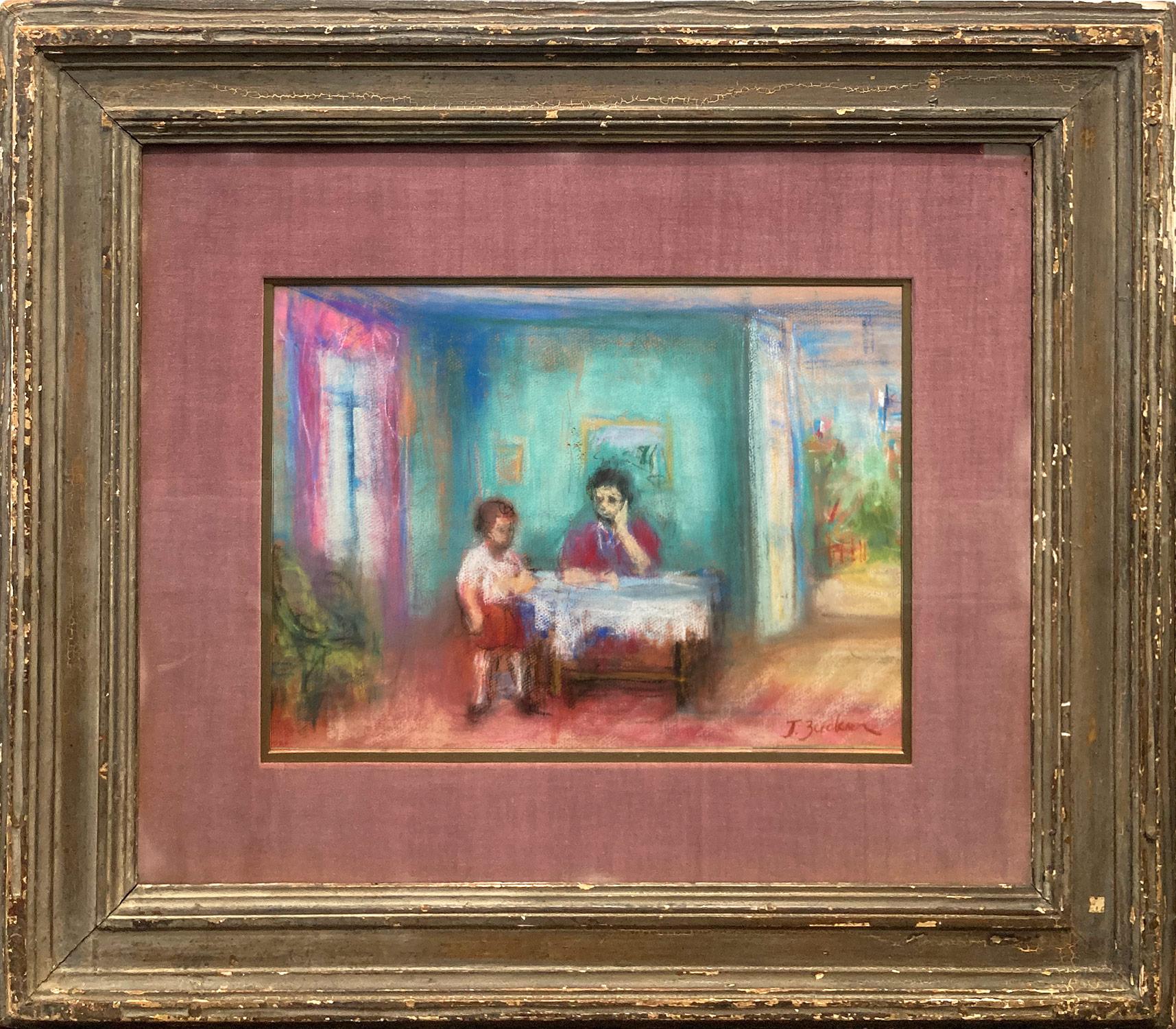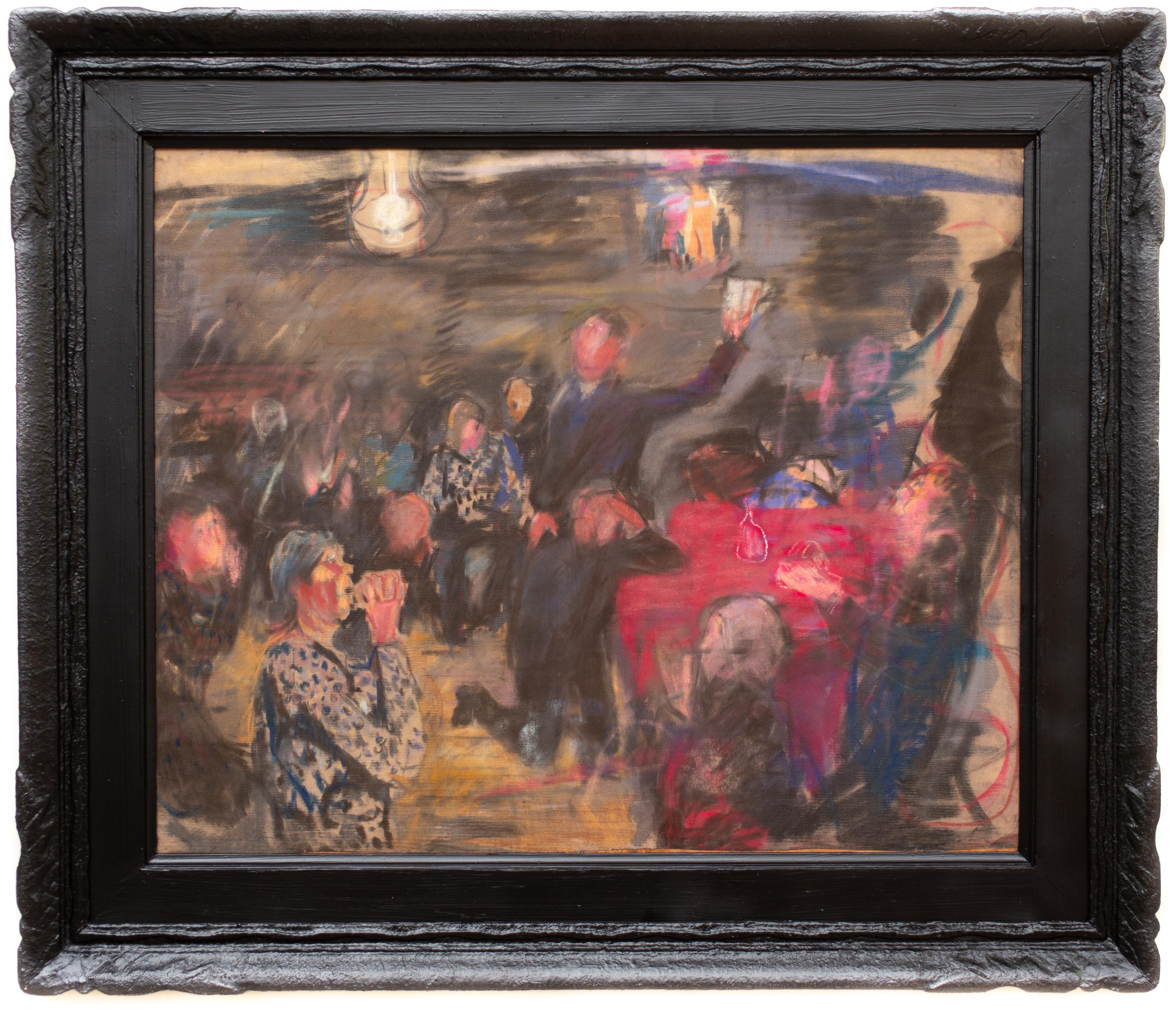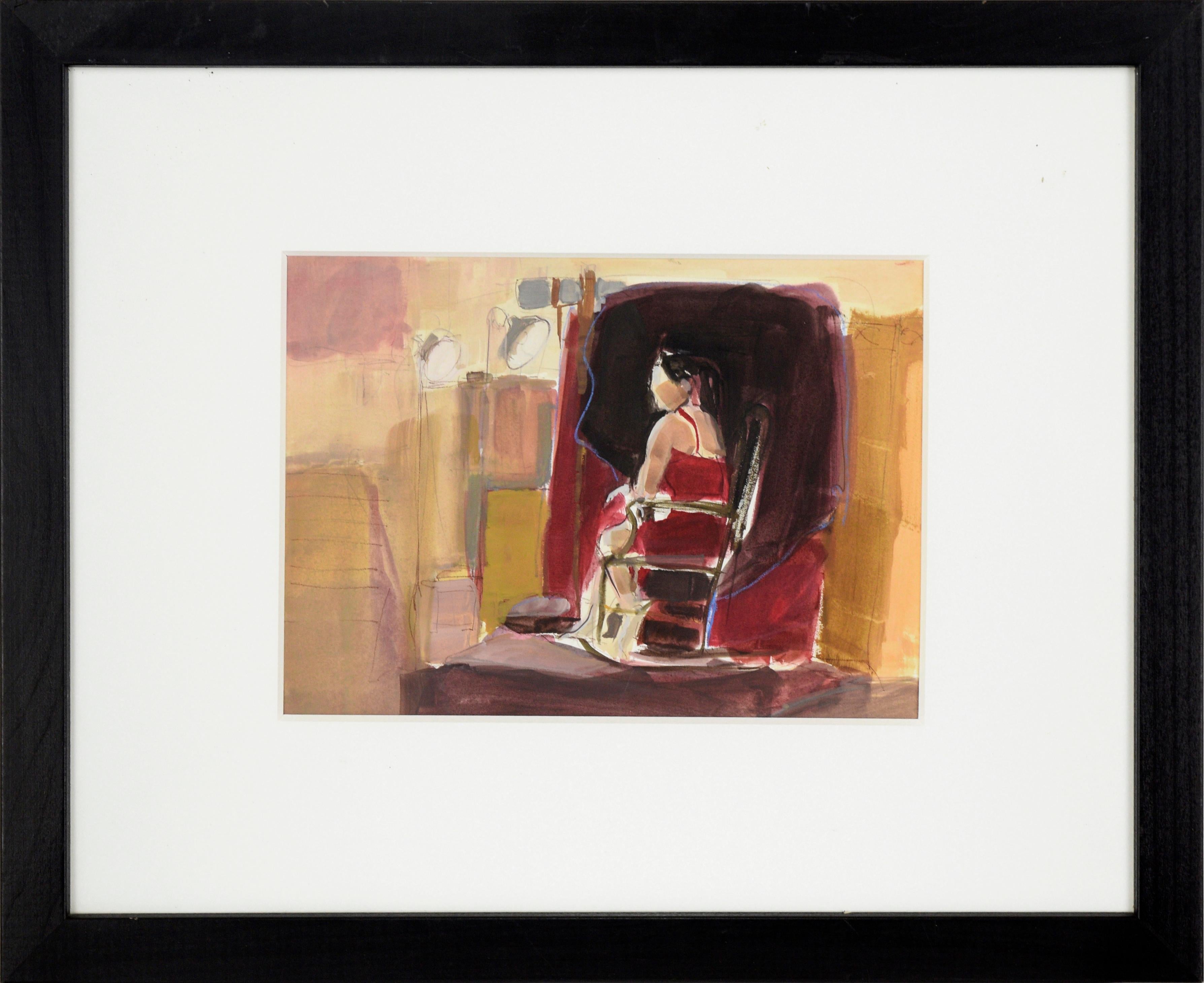Items Similar to Ballerina in the dressing room
Video Loading
Want more images or videos?
Request additional images or videos from the seller
1 of 10
Karl StohnerBallerina in the dressing room1924
1924
About the Item
Karl Stohner (1894 Mannheim - 1957 Paris), Ballerina in the dressing room, 1924. Pastel on painting cardboard, 65 x 45 cm, 77,5 x 59,5 (frame), signed lower left "Stohner" and dated "[19]24". Behind glass in gold stucco frame of the time.
- Painting cardboard slightly warped, in the lower area minimally stained, frame with age patina and traces of abrasion.
- The Naturalness of Artificiality -
We see a ballerina putting on her right ballet shoe while the left one is still lying on the floor in front of her. It is precisely the casualness of the scene that gives it its intimacy: the blonde young woman is completely absorbed in the activity of getting ready for the dance, oblivious to us, while we are positioned right in front of her in the dressing room, inaccessible to the audience, watching her dress. Even though she does not yet perform a dance step, there is a graceful elegance in the action shown that seems quite natural in contrast to the rehearsed art form of dance. The young woman is not presenting herself to an audience in a perfectly formed movement, but is performing an everyday action, unaware that she is being watched. Concentrated, almost devotional, she pulls the ballet slipper over the verses, not noticing that one of the straps of the tutu has slipped off her shoulder, reinforcing the erotic moment of the scene.
Inspired by Edgar Degas, Karl Stohner has painted the scene in strong pastel tones. The dominant blues and turquoises give the scene a magical, mysterious quality and, like the pink of the stockings and ballet slippers, are borrowed from Degas's dancers. Degas's colors, however, are cooler tempered, which is particularly evident in the light impasto applied incarnate. This is where the vividness of Auguste Renoir comes into play, making the dancer seem entirely flesh and blood. Karl Stohner, who has studied the pastels of Degas and Renoir intensively, combines the two artists here to create his own pictorial language.
He has laid out the background in broad layers of strokes, ranging in color from white to turquoise to dark blue. The result is a dynamic, pattern-like structure that contrasts with the woman's calm, inward-looking posture. The fund anticipates the dynamics of the choreography of the dance for which the ballerina is preparing. At the same time, the broad pastel line in the background is an adequate means of painting to depict the soft, flowing elegance of the dancer.
About the artist
Against the wishes of his wealthy parents, Karl Stohner decided to become a painter. His talent was discovered by the director of the Mannheim Art Gallery, Fritz Wichert, who supported him from then on, including financing study trips to Paris. There he discovered the art of Degas, Cézanne and Renoir, which inspired his work.
GERMAN VERSION
Karl Stohner (1894 Mannheim - 1957 Paris), Ballerina im Ankleideraum, 1924. Pastell auf Malkarton, 65 x 45 cm, 77,5 x 59,5 (Rahmen), unten links mit „Stohner“ signiert und auf „[19]24“ datiert. Hinter Glas im Goldstuckrahmen der Zeit.
- Malkarton leicht verzogen, im unteren Bereich minimal fleckig, Rahmen mit Alterspatina und Abriebspuren
- Die Natürlichkeit der Kunstform -
Wir sehen eine Ballerina, die sich den rechten Ballettschuh anzieht, während der linke noch vor ihr auf dem Boden liegt. Gerade aus der Beiläufigkeit der Szenerie speist sich ihre Intimität: Die blonde junge Frau geht ganz in der Tätigkeit auf, sich für den Tanz vorzubereiten, ohne uns dabei zu gewahren, während wir in dem für das Publikum unzugänglichen Umkleideraum genau vor ihr situiert sind und sie beim Ankleiden betrachten. Auch wenn sie noch keinen Tanzschritt vollführt, liegt in der gezeigten Handlung eine anmutige Eleganz, die im Gegensatz zur einstudierten Kunstform des Tanzes ganz natürlich wirkt. Die junge Frau präsentiert sich eben nicht in formvollendeter Bewegung vor einem Publikum, sondern vollführt eine ganz alltägliche Handlung, ohne zu wissen, dass sie dabei betrachtet wird. Konzentriert, beinahe hingebungsvoll zieht sie den Ballettschuh über die Verse und bemerkt nicht, dass ihr dabei ein Träger des Tutus von der Schulter gerutscht ist, was den erotischen Moment der Szene noch verstärkt.
Karl Stohner hat die an Edgar Degas inspirierte Darstellung in kräftigen Pastelltönen ausführt. Das dominierende Blau und Türkis verleiht der Szene etwas magisch Geheimnisvolles und ist ebenso wie das Rosa der Strümpfe und Ballettschuhe den von Degas dargestellten Tänzerinnen entlehnt. Degas Farben sind allerdings kühler temperiert, was sich insbesondere im hellen pastos aufgetragenen Inkarnat zeigt. Hier hält die Lebensfülle Auguste Renoirs Einzug ins Bild und lässt die Tänzerin ganz aus Fleisch und Blut erscheinen. Karl Stohner, der die Pastelle von Degas und Renoir intensiv studiert hat, vermählt hier beide Künstler miteinander und schafft damit eine eigene Bildsprache.
Den Hintergrund hat er in breiten Strichlagen angelegt, die farblich von Weiß über Türkis bis Dunkelblau reichen. Es entsteht eine musterförmige dynamische Struktur, die die ruhig in-sich-gekehrte Haltung der Frau konterkariert. Der Fonds nimmt gleichsam die Dynamik der Choreographie des Tanzes vorweg, auf den sich die Ballerina vorbereitet. Zugleich wird durch den Hintergrund der breite Pastellstrich als adäquates Malmittel thematisiert, die weiche fließende Eleganz er Tänzerin zu veranschaulichen.
zum Künstler
Entgegen dem Wunsch der wohlhabenden Eltern entschied sich Karl Stohner Maler zu werden. Sein Talent wurde vom Direktor der Mannheimer Kunsthalle, Fritz Wichert, entdeckt der ihn fortan förderte und Studienreisen unter anderem nach Paris finanzierte. Dort entdeckte er die Kunst von Degas, Cézanne und Renoir, die ihn in seinem Schaffen inspirierte.
- Creator:Karl Stohner (1894 - 1957, German)
- Creation Year:1924
- Dimensions:Height: 30.52 in (77.5 cm)Width: 23.43 in (59.5 cm)Depth: 1.97 in (5 cm)
- Medium:
- Movement & Style:
- Period:
- Condition:
- Gallery Location:Berlin, DE
- Reference Number:1stDibs: LU2438213066102

About the Seller
5.0
Vetted Seller
These experienced sellers undergo a comprehensive evaluation by our team of in-house experts.
Established in 2014
1stDibs seller since 2023
7 sales on 1stDibs
Typical response time: 7 hours
- ShippingRetrieving quote...Ships From: Berlin, Germany
- Return PolicyA return for this item may be initiated within 14 days of delivery.
More From This SellerView All
- Mary Magdalene - Faith transforms inner into outer beauty and conquers death -By Balthasar DennerLocated in Berlin, DEBalthasar Denner (1685 Hamburg - 1749 Rostock). Mary Magdalene. Oil on copper, 37 × 32 cm (visible size), 45 x 40 cm (frame), signed and indistinctly dated "Denner 17(...)" at centre...Category
1720s Old Masters Figurative Paintings
MaterialsCopper
- Still life with meadow flowers - The beauty of meadow flowers -Located in Berlin, DEJean-Baptiste Robie (1821 Brussels - 1910 ibid.). Still life with meadow flowers. Oil on wood, 24.5 x 18.5 cm (inside measurement), 37 x 31 cm (frame), signed and dated (difficult to...Category
Early 1900s Naturalistic Still-life Paintings
MaterialsCanvas, Oil
- Small Nude / - Abstract Figurativity -Located in Berlin, DEGustl Stark (1917 Mainz - 2009 ibid.), Small Nude, 1946. Oil on canvas, marouflaged, 54 x 25 cm (picture), 30 x 60 cm (frame), signed "Stark" top left, verso twice signed "Gustav Stark", inscribed by hand as "Small Nude" and dated by hand "1946". With label of the exhibition of the Bundeshaus Bonn from 1956. - Rubbed area in the lower third of the body, at the same level a retouch in the ochre background. I provisional frame. - Abstract Figurativity - About the artwork During the war, Gustl Stark suffered a particularly severe blow for an artist: he lost his right arm. Nevertheless, he continued to devote himself to art, and the painting, created in 1946, immediately after the end of the Nazi reign of terror, testifies to the dawn of a new era. At the same time, the work is a rare example of the artist's early figurative work, as Stark turned entirely to abstract painting as early as 1950. And even this painting is by no means purely figurative; rather, it already illustrates Stark's turn toward abstraction. We see a female nude, but one that remains faceless. This can be read symbolically and in relation to the immediate past epoch, which, in the face of horrors, silences and blinds - literally renders faceless. In this sense, the figure is positioned to 'look back'. But she does not look. While this meaning may resonate and make the painting an important work of the immediate postwar period, Gustl Stark is primarily concerned with something else here, namely art itself. The absence of the face leads to the body becoming something flat. Due to the de-individualization, we do not see a concrete person with his individual features, but a body surface. And indeed, the body is constructed through an extremely planar design. Even the contour lines that form the corporeality have a planar rather than a linear character, especially where they merge into shadow zones of almost the same color. And the surfaces themselves are not modeled. The incarnate parts do not show any plastic gradations; the corporeality is completely withdrawn into the plane, which is also true for the hair. In addition, there is no uniform background against which the figure could appear; rather, the area next to the hair is kept bluish, creating a succession of earth-toned colored areas, which again binds the figure to the surface. Last but not least, the flatness is also forced by the painting technique. Gustl Stark paints directly, a la prima, onto the coarse canvas, whereby the structure of the painting support remains visible in the picture, and in places - around the hair, for example - the canvas itself can be seen. This structural all-over lends the picture a certain flatness. Gustl Stark thus uses the very motif that stands for the corporeality of art par excellence - the female nude - to transform the spatiality of the traditional picture into a flatness characteristic of modern art. And yet, a strong impression of corporeality is created, without being produced by a painterly modeling of the body. The oscillation between flatness and corporeality creates the intense tension of this groundbreaking painting. In Gustl Stark's oeuvre, as a consequence of the abstraction we see here, the figurative is completely stripped away in a further step, which is also a loss when looking at this early key work. About the artist Gustl Stark was the son of a woodcarver and, after an apprenticeship as a decorative painter, attended the State School of Arts and Crafts in Mainz from 1936 to 1937. Although he was severely wounded in the war and lost his right arm, he studied at the Würzburg School of Painting and Drawing from 1943-1944 and then at the Academy of Fine Arts in Nuremberg from 1944-1948. He won a state scholarship at the state art competition in Bad Ischl. Numerous study trips to Sylt, Paris, Switzerland, Austria, Italy, Holland and Belgium followed. Gustl Stark worked in Mainz and was the first artist there to focus on abstract painting. His work quickly gained international recognition, including the Salon Réaliés Nouvelles in Paris. From 1963-1970 he taught at the State University Institute for Art and Work Education in Mainz and from 1970-1975 at the Johannes Gutenberg University. Gustl Stark became particularly famous for his color embossed prints, for which he invented his own technique. Gustl Stark received numerous awards for his work. He received the Art Prize for Painting of the City of Mainz in 1962, the State Prize of Rhineland-Palatinate in 1984, and the Gutenberg Bust of the City of Mainz in 1987. Selected Bibliography Hans Vollmer (Hrsg.): Allgemeines Lexikon der bildenden Künstler des XX. Jahrhunderts, Vierter Band, Leipzig 1958, S. 344. Hans H...Category
1940s Realist Nude Paintings
MaterialsCanvas
- The gift of flowersBy Conrad KieselLocated in Berlin, DEConrad Kiesel (1846-1921), The gift of flowers. Oil on wood, 43 x 35 cm, 69 x 61 cm (frame), signed at lower left "Conrad Kiesel pxt [pinxit]", about 1900. In a magnificent gilt stuc...Category
1890s Academic Nude Paintings
MaterialsOil
- Landscape with Trees by a Lake - Eternal summer silence over an abysmal lake -Located in Berlin, DEAndreas Thomas Juuel (1816 Copenhagen - 1868 Copenhagen). Summer landscape with tall deciduous trees by a lake. Oil on canvas, 54,5 x 42 cm (visible size), 71 x 58 cm (frame), signed...Category
1850s Realist Landscape Paintings
MaterialsOil
- Autumn Landscape in Sunlight - Indian Summer -Located in Berlin, DEFrederick Vezin (1859 Torresdale Philadelphia - 1933 Düsseldorf), Autumn Landscape in the Sunlight, oil on canvas, mounted on cardboard, 32 x 41 cm (inside measurement), 44 x 51 cm (...Category
Early 1900s Impressionist Landscape Paintings
MaterialsOil, Cardboard
You May Also Like
- Spanish dancers pastel drawingLocated in Barcelona, BarcelonaPierre Carro (1952) - Spanish Dancers - Pastel Drawing measurements 45x34 cm. Frame measurements 93x79 cm.Category
1980s Post-Impressionist Figurative Paintings
MaterialsPastel
- "Interior Scene with Figures in Living Room" Post-Impressionist Oil PaintingBy Jacques ZuckerLocated in New York, NYA whimsical interior scene depicting two figures in the living room with an older person and young boy, perhaps Father and son with a door open into the background which shows Parisi...Category
20th Century Post-Impressionist Interior Paintings
MaterialsArchival Paper, Oil Pastel
- Party Time by Swedish Artist Eric Hallström, Pastel on PaperLocated in Stockholm, SEEric Hallström (1893-1946) Swedish Party Time pastel on paper signed Eric Hallström image dimensions approx 19.29 x 23.22 inches (49 x 59 cm) frame 26.37 x 30.70 inches (67 x 78 cm...Category
1920s Figurative Paintings
MaterialsPastel, Paper
- Christ, Charcoal & Pastel on Canvas, Black by Contemporary Artist "In Stock"By Bratin KhanLocated in Kolkata, West BengalBratin Khan - Christ Charcoal & Pastel on Canvas, 30 x 24 inches, 2009 The anecdotes and narratives of Krishna's life are generally titled as Krishna Leela. He is a central character in the Mahabharata, the Bhagavata Purana and the Bhagavad Gita, and is mentioned in many Hindu philosophical, theological, and mythological texts. They portray him in various perspectives: a god-child, a prankster, a model lover, a divine hero, and as the universal supreme being. His iconography reflects these legends, and shows him in different stages of his life, such as an infant eating butter, a young boy playing a flute, a young man with Radha or surrounded by women devotees, or a friendly charioteer giving counsel to Arjuna. He is sometimes accompanied by cows or a calf, which symbolise the divine herdsman Govinda. Alternatively, he is shown as a romantic and seductive man with the gopis (milkmaids), often making music or playing pranks. Style : Marked for the refined handling of line work and palette, his painterly compositions, reflect influences of folk art and Bengal School. The renderings are poetic and the narratives mythical, folklore-inspired or religious. His curvaceous and languid figures, often accompanied by a surrounding halo, are set amidst a natural habitat. The imagery features Buddha, Krishna, other legendry icons as well as pretty damsels and lotus flowers. Figures dominate the whole thinking process of his paintings with different subjects such as mermaids, musicians (Classical Musicians , Rajasthani Folk Singers and Baul Singers) and mythological figures appearing in his works. He was deeply influenced by the life Sri Aurobindo and thus enlightened beings. Such as Buddha, Jesus and Krishna are also a recurring theme in his Golden Man series. His focus on detail and remarkable skill over the line make his style unique. He uses a traditional method of tempera painting which goes back to the Indian miniature though the material he uses is totally contemporary. Knowledge of the wash technique further enables him to create a soft, twilight effect in his paintings. About the Artist and his work : Born : 1969, West Bengal. Education : 1993 Bachelor of Fine Arts (Painting), Visva Bharati University, Santiniketan. Selected Solo Exhibitions : 2000 - Classic Source, Mumbai. 1999 - Rightlines Art Gallery, Bangalore. 1993 - Grindlays Bank Gallery, Kolkata. Selected Group Exhibitions : 2007 - ‘A Brush with Durga’ ,Gallery Kolkata, Kolkata. 2002 - 'Gems of Bengal Art...Category
2010s Contemporary Figurative Paintings
MaterialsCharcoal, Pastel, Mixed Media, Canvas
- Model in the Studio - Figurative in Gouache and Pastel on PaperLocated in Soquel, CAEvocative figurative painting of a woman seated in a studio by an unknown artist (20th Century). A woman dressed in red is sitting in a chair atop a platform. There are studio lights...Category
Early 2000s American Impressionist Figurative Paintings
MaterialsPaper, Pastel, Gouache
- SojournerLocated in Ibadan, Oyo"Sojourner" by Morakinyo Femi is a captivating artwork that presents a young man seated in a fashionable attire, adorned with striking jewelry and sport...Category
1970s Contemporary Figurative Paintings
MaterialsOil, Pastel, Canvas, Acrylic
Recently Viewed
View AllMore Ways To Browse
Gold Tone Watches Woman
Paintings Ballerina Pink
Ballerina Impressionist Art
Dior Ballet Shoes
Blue Ballerina Art
Watches With Turquoise
Strasbourg Art
Painting And Woman Waiting
Led Prince
Flat Byzantine
J Thompson Impression
Male Academy
Natasha Lelenco
Orologio Vintage
Sasja W
Sasja Wagenaar
Jose Munoz
Watch Vintage Nelsonic Watch




